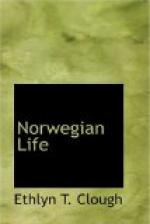Nine-tenths of the farms of Norway and Sweden are owned by small proprietors; and although the right to dispose of landed property is relatively free, the laws of the country favor the retention of the farms in the families possessing them. An old allodial right makes it possible to redeem at an appraised value a farm that has been sold. This right is acquired after the property has belonged to the family for twenty years, but it is lost after the farm has been in the possession of strangers for three years. There are some farms that have been worked for a thousand years by the descendants of the same family. The best farms are about the banks of the lakes and in the narrow river valleys, and there are many fertile meadows which have never been plowed or put under cultivation, so that there are great future possibilities for tillage. And yet these meadows furnish fine hay-crops, and every blade of grass represents money in Scandinavia.
In a country extending through thirteen degrees of latitude, one might naturally expect a wide range of agricultural products. In the southeastern part of the peninsula most of the plants and orchard fruits of central Europe are found; whereas in the northern sections it is impossible to grow even the most hardy plants. Oats, barley, and rye are the chief cereals, but their production scarcely meets the needs of the country. Potatoes are the only root crops extensively cultivated. While the summers are short, vegetables and small fruit do excellently during the long, sun-lit hours. Scandinavians, however, do not seem habituated to a vegetable diet, and the cultivation of root plants seems very generally neglected. Pears, cherries, apples, raspberries, gooseberries, and currants may be grown under favorable conditions; but they play a minor role in Scandinavian horticulture.
The cow is a staple of wealth to the people of Scandinavia. They are diminutive in size, dun-colored, docile in habits, and excellent milk producers. It is said when they are well-fed they average from six to nine hundred gallons of milk a year. The mountain saeters, or dairies as we would call them, are the centers of the butter and cheese industry during the summer months.
The peninsula is also supplied with an excellent breed of small but hardy horses. The cream-colored fjord horses of Norway are only sixty inches high. They are active, hardy, and gentle; and in the mountainous parts of the country they are vastly more serviceable than mules would be. The Gudbrandsdalen breed, found chiefly in the mountain valleys, are larger than the fjord horses, and they are generally brown or black in color. Good horses bring surprisingly high prices. Working horses cost from $200 to $350 and the best stallions bring as much as $2,500.
The agricultural interests of Norway have suffered unmistakably by the enormous emigration to the United States. Two-thirds of the Norwegians of the world live in Iowa, Wisconsin, Minnesota, and the Dakotas. Nearly every Norwegian farmstead has kinsmen in our country; and the strong and vigorous always emigrate, thus leaving the farms at home in the hands of the old and infirm. America has been greatly benefited by this almost incessant exodus; for the Norse peasants have, without an exception, made splendid citizens, the best, in fact, that have come to us from Europe.




